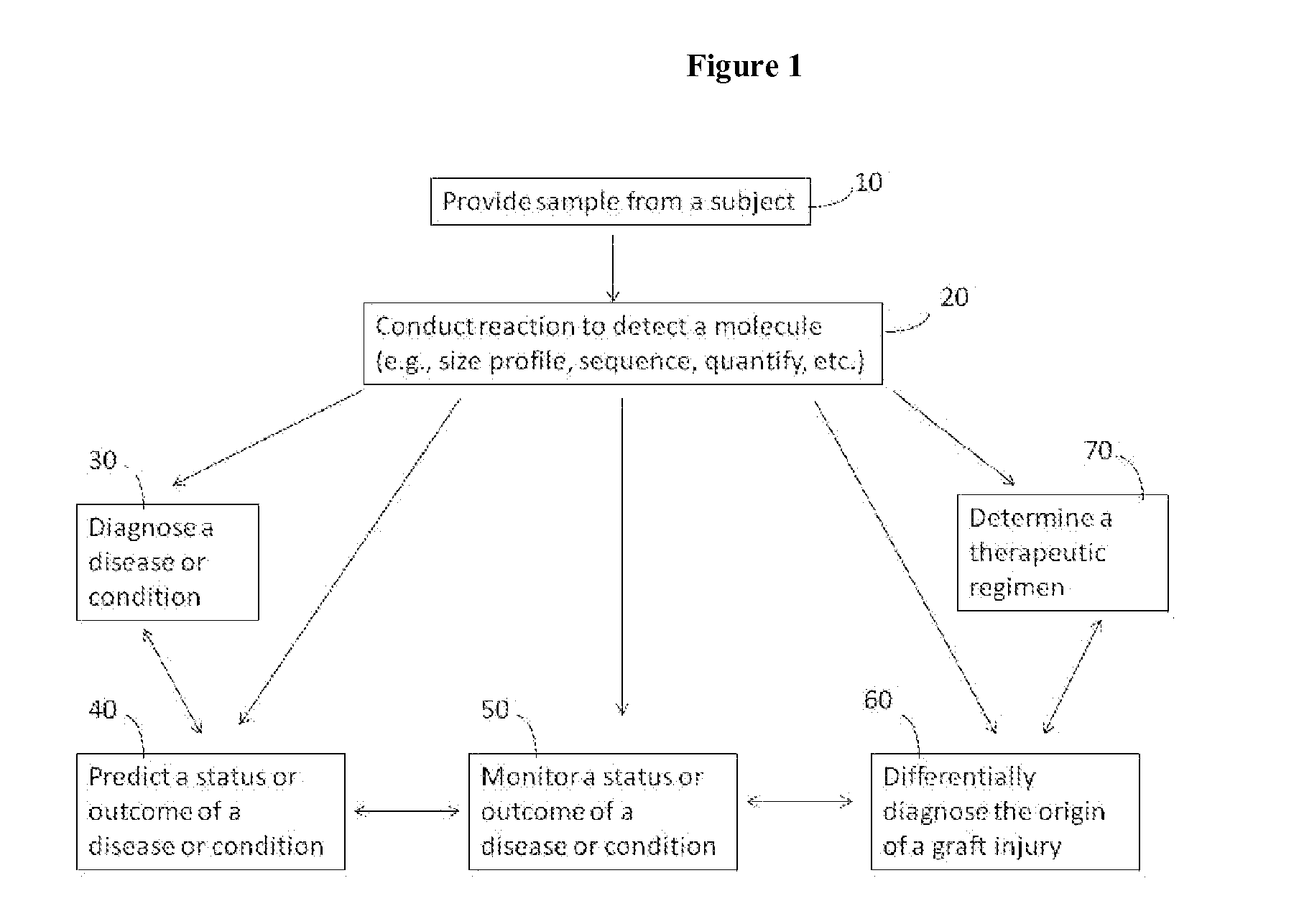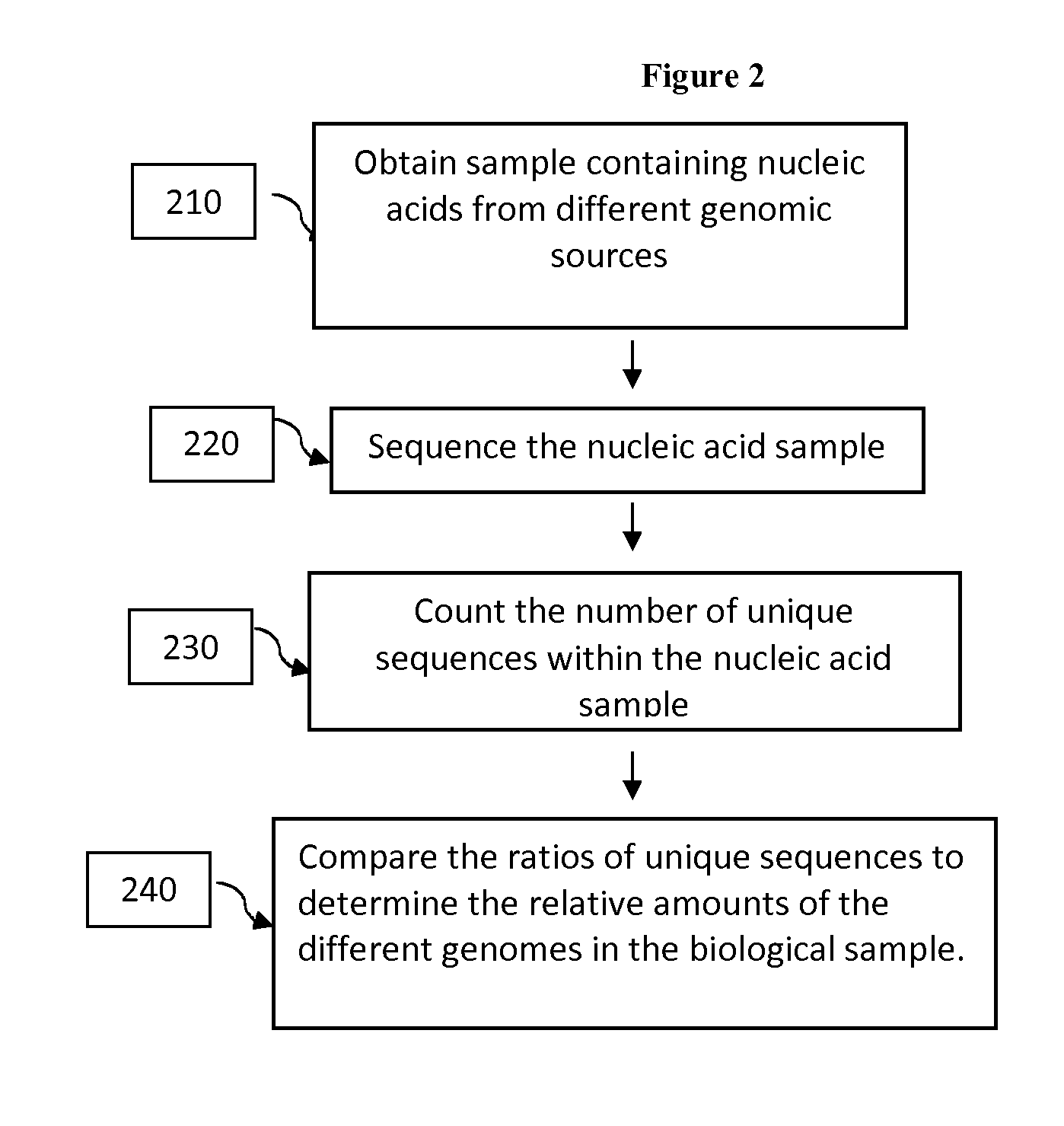Compositions and methods for analyzing heterogeneous samples
a technology applied in the field of composition and analysis method of heterogeneous samples, can solve the problems of difficult detection or differentiation of foreign genomes within biological samples taken from the host, and achieve the effect of reducing or stopping the therapeutic regimen
- Summary
- Abstract
- Description
- Claims
- Application Information
AI Technical Summary
Benefits of technology
Problems solved by technology
Method used
Image
Examples
example 1
Differential Diagnosis of the Origin of a Graft Injury
[0343]In response to a rise in donor DNA levels, differential diagnosis of the origin of graft injury can be performed by looking at the size profile of donor DNA molecules identified in the cell-free fraction. Cell-free DNA is released from both apoptotic and necrotic cells, but the size distribution of DNAs differs in these two cases. Apoptotic cell death involves nuclease digestion of the genomic DNA while still bound to nucleosomes prior to release from the cell. Consequently, apoptotic contributions to the cell-free DNA are small fragments that form a ladder of sizes starting around 180 bp, then 360 bp, then 540 bp, and so on with the majority of molecules at the smallest sizes. Necrotic cell death is not as orderly and the released DNA is generally of a larger size, and is not digested into a smooth ladder of sizes but instead is a smear. Different causes of graft injury can give a different proportion of apoptotic and necr...
example 2
Predicting Transplant Rejection
[0345]A blood sample from a transplant recipient is analyzed for donor-derived DNA in order to predict a risk of transplant rejection. The donor-derived cell-free DNA is detected via sequencing. Long-sequencing technology is used to sequence at least about 1500 bp of the donor-derived cell-free DNA. The amount of donor-derived cell-free DNA is quantified by counting the number of sequence reads. A transplant rejection is predicted if the total percentage of the donor-derived cell-free DNA is greater than about 1% of the total DNA in the sample.
example 3
Modifying an Immunosuppressive Regimen
[0346]A urine sample from a liver transplant recipient treated with an immunosuppressive regimen is analyzed for donor-derived DNA in order to monitor an immunosuppressive regimen. A small fragment sample is generated by isolating DNA fragments less than about 150 base pairs from the urine sample. The amount of donor-derived DNA in the small fragment sample is determined by quantitative PCR. The amount of donor-derived DNA is less than about 0.5% of the total DNA in the small fragment sample, indicating that the donor graft is healthy. As a result of the healthy graft, one or more immunosuppressive drugs in the immunosuppressive regimen are reduced.
[0347]Alternatively, multiple urine samples are obtained from a heart transplant recipient treated with an immunosuppressive regimen are analyzed for kidney-derived DNA in order to monitor an immunosuppressive regimen. The urine samples are collected at different time points (e.g., 0 days, 7 days, 14 ...
PUM
| Property | Measurement | Unit |
|---|---|---|
| Fraction | aaaaa | aaaaa |
| Time | aaaaa | aaaaa |
| Size | aaaaa | aaaaa |
Abstract
Description
Claims
Application Information
 Login to View More
Login to View More - R&D
- Intellectual Property
- Life Sciences
- Materials
- Tech Scout
- Unparalleled Data Quality
- Higher Quality Content
- 60% Fewer Hallucinations
Browse by: Latest US Patents, China's latest patents, Technical Efficacy Thesaurus, Application Domain, Technology Topic, Popular Technical Reports.
© 2025 PatSnap. All rights reserved.Legal|Privacy policy|Modern Slavery Act Transparency Statement|Sitemap|About US| Contact US: help@patsnap.com


